MIYAGISHIMA, Shin-ya D. Sc., Project Associate Professor
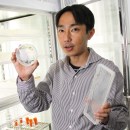
- Symbiosis and Cell Evolution Laboratory, Miyagishima Group
- Present Post (since 2011)
Unit Leader, Initiative Research Program, RIKEN, Japan
Postdoctoral Fellow, Michigan State University, USA
Postdoctoral Fellow, Rikkyo University, Japan
Ph. D., Department of Biological Science, Graduate School of Science, University of Tokyo, Japan
Awards: Hirase Award, Japanese Society of Plant Morphology, 2010 The Early Career Award, American Society of Plant Biologists, 2005 Young Scientist Award, Botanical Society of Japan, 2004 Young
Scientist Award, Japanese Society of Plant Morphology, 2002
Hobbies: Having drinks with friends
Mitochondria and chloroplasts: mystery of symbiosis and evolution of cells of different species
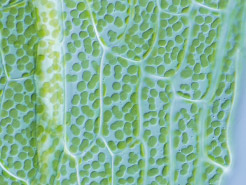 Mitochondria and chloroplasts are organelles. It is believed that in ancient times they were autonomous organisms but more than 1 billion years ago they were merged into eukaryotic cells. How were cells of different organisms integrated to live in one? Focusing on the division of mitochondria and chloroplasts, Project Assistant Professor Shin-ya MIYAGISHIMA and his group are trying to understand how the mechanism of integration has evolved.
Mitochondria and chloroplasts are organelles. It is believed that in ancient times they were autonomous organisms but more than 1 billion years ago they were merged into eukaryotic cells. How were cells of different organisms integrated to live in one? Focusing on the division of mitochondria and chloroplasts, Project Assistant Professor Shin-ya MIYAGISHIMA and his group are trying to understand how the mechanism of integration has evolved.
- Process of two cells becoming one
- I began by asking how Dr. Miyagishima had arrived at this research theme.
- “Initially, I was interested in observing the shapes of materials in cells. I started the research as a graduate student as I was curious about how chloroplasts and mitochondria moved or increased. This led to questions about evolution and all the rest. At present, I’m most interested in the process in which an originally independent organism is taken into another, the process in which two cells become one, with one living inside the other.”
- He says there are only a few laboratories in the world that conduct research from such a standpoint.
- “I know there are about four laboratories in the United States that are working on the division of mitochondria, but they use budding yeasts. Mitochondria have enormously evolved and diversified, and they are largely different from one organism to the other. So it’s very difficult to discover something that is common to all life forms. You can make a discovery, but that’s often applicable to yeasts only. In biological research, an unlimited number of discoveries are possible if you study different organisms. But this becomes endless. Do you want to study all the genetic functions? That’s impossible and meaningless, because the genes are different from one organism to another and they continue to evolve and change. I’m more attracted to the kind of research that leads to a larger picture, laws and principles. What I really want to understand is how bacteria are engulfed into cells and they come to live and multiply as one.”
- Division ring formed with cyanobacterial and host cell proteins
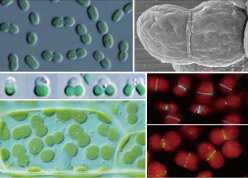 Prior to cell division, chloroplasts and mitochondria are divided and duplicated into two and equally distributed among the daughter cells. At the time of division of chloroplasts and mitochondria, a ring-shaped structure appears, shrinks and divides into two. Upon the completion of division, the ring dissolves. In his previous research, Dr. Miyagishima clarified the structure and composition of the ring. Since they are roughly identical for chloroplasts and mitochondria, I asked him to focus on the former.
Prior to cell division, chloroplasts and mitochondria are divided and duplicated into two and equally distributed among the daughter cells. At the time of division of chloroplasts and mitochondria, a ring-shaped structure appears, shrinks and divides into two. Upon the completion of division, the ring dissolves. In his previous research, Dr. Miyagishima clarified the structure and composition of the ring. Since they are roughly identical for chloroplasts and mitochondria, I asked him to focus on the former.- “Chloroplasts were originally cyanobacteria. When cyanobacteria divide, a ring forms inside and shrinks until division occurs. The division ring of chloroplasts contains the protein FtsZ, which is also found in the ring of cyanobacteria. FtsZ forms inside the chloroplast. On the other hand, dynamine, a protein that is generated by the host cell and not found in cyanobacteria, forms outside the chloroplast. Division cannot occur without FtsZ and dynamine, as well as ARC, which came from cyanobacteria, and PDV, another protein from the host cell not found in cyanobacteria.
- That is to say, the division ring is a combination of cyanobacterial proteins and host cell-originated proteins. The genes for producing these proteins are completely transferred to the host cell.
- “There are some genes still remaining in the chloroplast, but the one that makes FtsZ is no longer there; it’s moved to the nucleus of the host cell. The gene is taken away and can’t be used freely.”
- In other words, it is the host cell that completely controls the division of the chloroplast.
- Culturing various organisms to study the process of their evolution
- Dr. Miyagishima’s laboratory cultures various organisms to trace the process of their evolution, including cyanobacteria, the “ancestor” of chloroplasts; Physarum without chloroplasts; algae which have one to three chloroplasts; and the land plant Arabidopsis thaliana. They have recently started the culture of the protista called “Paulinella,” an organism that has been taken in cyanobacteria of a different origin from that of the chloroplast.
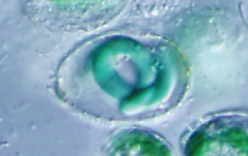 “It’s only recently that the cyanobacteria in Paulinella are found to be different from the chloroplasts. It’s impossible to decide whether the chloroplast found in the cell is really an endosymbiont or some kind of residue without conducting monoculture, but monoculture of organisms is extremely difficult. In some cases, it is simply impossible because most organisms rely on products by others for survival. It is even said that the organisms that we have managed to culture so far account for less than 1% of all the life forms on earth. So it’s quite possible that there are so many organisms like Paulinella that conduct endosymbiosis; we just don’t know about them.”
“It’s only recently that the cyanobacteria in Paulinella are found to be different from the chloroplasts. It’s impossible to decide whether the chloroplast found in the cell is really an endosymbiont or some kind of residue without conducting monoculture, but monoculture of organisms is extremely difficult. In some cases, it is simply impossible because most organisms rely on products by others for survival. It is even said that the organisms that we have managed to culture so far account for less than 1% of all the life forms on earth. So it’s quite possible that there are so many organisms like Paulinella that conduct endosymbiosis; we just don’t know about them.”- New discoveries are expected from research using little-known organisms.
- Four mysteries to elucidate
- Dr. Miyagishima’s laboratory is determined to elucidate four major mysteries.
- “Firstly, we still have the big question unanswered: how does the ring shrink? We don’t know how the interior and the exterior are connected. How do materials of different origins shrink together? Secondly, the timing of generation of the division ring of mitochondria and chloroplasts is controlled by the host, but we don’t know how – how to increase, how to stop. Thirdly, in the opposite direction from the second mystery, we want to know what the engulfed side does to the host, considering that the host cells cannot increase without photosynthesis by chloroplast, and without breathing by mitochondria. Fourthly, we want to understand all forms of endosymbiosis. For example, Paramecium keeping chlorella and cells taken inside salamanders for photosynthesis, as well as intermediate organisms that are currently undergoing symbiosis to get ideas for future research.”
- Artificial endosymbiosis?
- Dr. Miyagishima also speaks of “artificial chloroplast,” as one of his more ambitious research goals.
- “Our ultimate aim is to succeed in realizing endosymbiosis artificially, in the form of artificial chloroplast or artificial control. It may be possible to artificially produce endosymbionts by manipulating division by mixing cyanobacteria and amoebae, getting the latter to eat the former. In the case of organisms which are about to undergo symbiosis, most genes of the bacteria that are being integrated are yet to be totally taken up by the host. This makes me think that it may be possible to increase together with minimum manipulation. Many things can’t happen all at once in the process of evolution. So I think changes occur one by one, and they get gradually tuned up. So I want to identify the very first event that occurs. With this finding, perhaps we’ll be able to produce artificial chloroplasts.
- How our cells, eukaryotic cells, came into existence
- Finally, I asked Dr. Miyagihashi about the significance of his research.
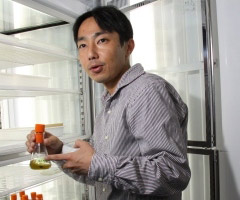 “It is absolutely clear that my research is pure basic research. So it doesn’t readily lead to the development of something useful or the dissolution of energy or other problems in society. Still, wanting to learn and discover is a strong human desire. It’s a little like art appreciation. We don’t need it to live, but our lives would be less interesting without it. We don’t need it, of course, if we are to live like machines or livestock. Dinosaurs used to exist only tens of millions of years ago, whereas eukaryotic cells have evolved over billions of years. But how? I want to know. I believe that discovering how they, and human cells, came into being is extremely important.”
“It is absolutely clear that my research is pure basic research. So it doesn’t readily lead to the development of something useful or the dissolution of energy or other problems in society. Still, wanting to learn and discover is a strong human desire. It’s a little like art appreciation. We don’t need it to live, but our lives would be less interesting without it. We don’t need it, of course, if we are to live like machines or livestock. Dinosaurs used to exist only tens of millions of years ago, whereas eukaryotic cells have evolved over billions of years. But how? I want to know. I believe that discovering how they, and human cells, came into being is extremely important.”- (Interviewed by Yoshiko Tamura 2011)















